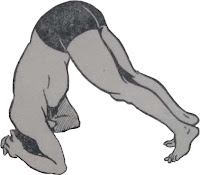Shirshasana or Head Stand Pose or Inverted asana is balancing whole body on your head with the help of your hands or forearms, taking your legs in the upward direction. It is exactly opposite to standing on to the feet. This is also called as Yoga Position on Head and Hands.
The exact position of this asana looks like below image. It is one of the important asana which should be done daily. It has many benefits that every person needs in today’s unhealthy life style.
 |
| Shirshasana or Head stand pose |
It looks little difficult to do initially but if you practice it daily with proper steps you will be able to master it soon. But don’t make any hurry to achieve it. It is called Yoga Position on Head and Hands because in this position one needs to balance whole body only on Head and both the Hands.
If you are doing it for first time, you should follow Shirshasana procedure provided below (1, 2 and 3) and should go in same sequence step by step to achieve the final pose. Please don’t try to do the final step directly else it might harm you.
Shirshasana for beginner
When you do it for first time or doing it after long time, you should follow below steps to achieve the final pose. We have provided the images of different Shirshasana steps to make it easier to start. Always lay a soft cloth or a mat on ground and practice yoga on it.
- Sit on the knees and interlock the fingers of both the hands. Keep interlocked fingers on the floor and keep crown of the head on it (palm of hands). See Fig. below

Shirshasana Step 1 - Lift your buttock slowly and transfer your body weight on head. Once you are comfortable with this go for next step. See Fig. 2

Shirshasana Step 2 - Slowly lift your legs in upward direction. Don’t keep legs straight until you can balance them properly in the air. See Fig. 3

Shirshasana Step 3 - Once you will get a fine balance of the legs, try to make your legs straight slowly. This is a final step.
Shirshasana time
Shirshasana precautions
- Keep breathing normal. If you feel any problem in breathing while being in this pose, please stop it immediately.
- If you feel anything like dizziness, headache immediately stop it.
- When you have headache, toothache, pains or itching in eyes, please don’t do this asana.
- If you have any type of blood pressure don’t do it because in Shirshasana, all blood flow goes toward your head which may cause serious problem to the BP patients.
- Don’t do it when you have fever or weakness etc.
- Person with any injury should always avoid it as this pose needs real strength to lift your body and keep it on head with the help of arms for some time.
Shirshasana Benefits
- Yoga poses are designed in such a way that it makes tremendous effect on all the glands in the human body. To stimulate these glands and for their good functioning, all they need is a sufficient blood flow, which is controlled by brain. In this pose, the brain gets a good amount of blood flow to blood vessels.
- Humans always stand on their feet, due to which brain gets less blood flow which ultimately causes to headache, dizziness etc. it gives good amount of blood flow to the brain which removes the root cause of headache, dizziness etc. or reduces the chances of headache, dizziness etc.
- Regular practice of the it gets a natural enthusiasm which keep person fresh and active whole day.
- It also reduces the constipation. Due to inverted position, it decreases the stress on digestive system which ultimately causes in reducing constipation.
- It increases the power of spinal cord, arms, legs as full body weight goes on these three organs.
- Brain is controller of blood supply to whole body and as the brain becomes more active due to good blood supply It also improves the blood circulation in whole body.
- Beneficial in relieving stress and stimulates brain cells due to proper blood circulation.
- It improves functioning of abdomen.
- It stimulates the pituitary and pineal glands.
- It strengthens the lungs.